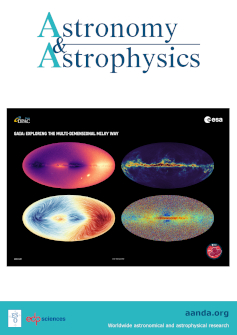Vertical shear instability with dust evolution and consistent cooling times
IF 5.4
2区 物理与天体物理
Q1 ASTRONOMY & ASTROPHYSICS
引用次数: 0
Abstract
Context. Gas in protoplanetary disks mostly cools via thermal accommodation with dust particles. Thermal relaxation is thus highly sensitive to the local dust size distributions and the spatial distribution of the grains. So far, the interplay between thermal relaxation and gas turbulence has not been dynamically modeled in hydrodynamic simulations of protoplanetary disks with dust.Aims. We aim to study the effects of the vertical shear instability (VSI) on the thermal relaxation times, and vice versa. We are particularly interested in the influence of the initial dust grain size on the VSI and whether the emerging turbulence is sustained over long timescales.Methods. We ran three axisymmetric hydrodynamic simulations of a protoplanetary disk including four dust fluids that initially resemble MRN size distributions of different initial grain sizes. From the local dust densities, we calculated the thermal accommodation timescale of dust and gas and used the result as the thermal relaxation time of the gas in our simulation. We included the effect of dust growth by applying the monodisperse dust growth rate and the typical growth limits.Results. We find that the emergence of the VSI is strongly dependent on the initial dust grain size. Coagulation also counteracts the emergence of hydrodynamic turbulence in our simulations, as shown by others before. Starting a simulation with larger grains (100 μm) generally leads to a less turbulent outcome. While the inner disk regions (within ∼70 au) develop turbulence in all three simulations, we find that the simulations with larger particles do not develop VSI in the outer disk.Conclusions. Our simulations with dynamically calculated thermal accommodation times based on the drifting and settling dust distribution show that the VSI, once developed in a disk, can be sustained over long timescales, even if grain growth is occurring. The VSI corrugates the dust layer and even diffuses the smaller grains into the upper atmosphere, where they can cool the gas. Whether the instability can emerge for a specific stratification depends on the initial dust grain sizes and the initial dust scale height. If the grains are initially ≳100 μm and if the level of turbulence is initially assumed to be low, we find no VSI turbulence in the outer disk regions.垂直切变不稳定性与尘埃演变和一致的冷却时间
背景原行星盘中的气体主要是通过与尘埃粒子的热容来冷却的。因此,热弛豫对当地尘埃大小分布和颗粒的空间分布非常敏感。迄今为止,在对有尘埃的原行星盘进行流体力学模拟时,尚未对热弛豫与气体湍流之间的相互作用进行动态建模。我们旨在研究垂直剪切不稳定性(VSI)对热弛豫时间的影响,反之亦然。我们尤其感兴趣的是初始尘粒大小对垂直剪切不稳定性的影响,以及新出现的湍流是否会在长时间尺度上持续。我们对一个原行星盘进行了三次轴对称流体力学模拟,其中包括四种尘埃流体,它们最初类似于不同初始粒度的 MRN 粒度分布。根据局部尘埃密度,我们计算了尘埃和气体的热容纳时间尺度,并将计算结果作为模拟中气体的热弛豫时间。我们采用单分散尘埃生长率和典型生长极限来计算尘埃生长的影响。我们发现,VSI 的出现与初始粉尘粒度密切相关。在我们的模拟中,凝结也会抵消流体动力湍流的出现,这与之前其他人的研究结果一致。以较大的颗粒(100 μm)开始模拟通常会导致较小的湍流结果。在所有三种模拟中,内盘区域(70au以内)都出现了湍流,但我们发现使用较大颗粒的模拟在外盘区没有出现VSI。我们根据漂移和沉降尘埃分布动态计算热容纳时间的模拟结果表明,VSI 一旦在圆盘中形成,就可以在较长的时间尺度内持续下去,即使颗粒正在生长。VSI 会使尘埃层呈波纹状,甚至会将较小的颗粒扩散到高层大气中,从而冷却气体。特定分层是否会出现不稳定性取决于初始尘粒大小和初始尘粒尺度高度。如果初始尘粒大小为≳100 μm,并且假设初始湍流水平较低,我们就会发现外盘区域没有 VSI 湍流。
本文章由计算机程序翻译,如有差异,请以英文原文为准。
求助全文
约1分钟内获得全文
求助全文
来源期刊

Astronomy & Astrophysics
地学天文-天文与天体物理
CiteScore
10.20
自引率
27.70%
发文量
2105
审稿时长
1-2 weeks
期刊介绍:
Astronomy & Astrophysics is an international Journal that publishes papers on all aspects of astronomy and astrophysics (theoretical, observational, and instrumental) independently of the techniques used to obtain the results.
 求助内容:
求助内容: 应助结果提醒方式:
应助结果提醒方式:


